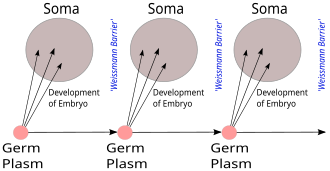
Back حاجز وايزمان Arabic Weismann-Barriere German Barrera Weismann Spanish Barrière de Weismann French Barreira de Weismann Galician מחסום וייסמן HE Weismann-elv Hungarian Weismannbarrière Dutch Weismannbarrieren NB Vajsmanova barijera Serbo-Croatian

The Weismann barrier, proposed by August Weismann, is the strict distinction between the "immortal" germ cell lineages producing gametes and "disposable" somatic cells in animals (but not plants), in contrast to Charles Darwin's proposed pangenesis mechanism for inheritance.[1][2]
In more precise terminology, hereditary information is copied only from germline cells to somatic cells. This means that new information from somatic mutation is not passed on to the germline. This barrier concept implies that somatic mutations are not inherited.[3][4]
Weismann set out the concept in his 1892 book ″Das Keimplasma: eine Theorie der Vererbung″ (German for The Germ Plasm: a theory of inheritance).[5] The use of this theory, commonly in the context of the germ plasm theory of the late 19th century, before the development of better-based and more sophisticated concepts of genetics in the early 20th century, is sometimes referred to as Weismannism.[6] Some authors distinguish Weismannist development (either preformistic or epigenetic) that in which there is a distinct germline, from somatic embryogenesis.[7] This type of development is correlated with the evolution of death of the somatic line.
The Weismann barrier was of great importance in its day and among other influences it effectively banished certain Lamarckian concepts: in particular, it would make Lamarckian inheritance from changes to the body (the soma) difficult or impossible.[8] It remains important, but has however required qualification in the light of modern understanding of horizontal gene transfer and some other genetic and histological developments.[9]
- ^ Geison, G. L. (1969). "Darwin and heredity: The evolution of his hypothesis of pangenesis". J Hist Med Allied Sci. XXIV (4): 375–411. doi:10.1093/jhmas/XXIV.4.375. PMID 4908353.
- ^ You, Yawen (26 January 2015). "The Germ-Plasm: a Theory of Heredity (1893), by August Weismann". The Embryo Project Encyclopedia (Arizona State University). Retrieved 7 September 2018.
- ^ Gauthier, Peter (March–May 1990). "Does Weismann's Experiment Constitute a Refutation of the Lamarckian Hypothesis?". BIOS. 61 (1/2): 6–8. JSTOR 4608123.
- ^ This does not refer to the central dogma of molecular biology, which states that no sequential information can travel from protein to DNA or RNA, but both hypotheses relate to a gene-centric view of life. De Tiege, Alexis; Tanghe, Koen; Braeckman, Johan; Van de Peer, Yves (January 2014). "From DNA- to NA-centrism and the conditions for gene-centrism revisited". Biology & Philosophy. 29 (1): 55–69. doi:10.1007/s10539-013-9393-z. S2CID 85866639.
- ^ Weismann, August (1892). Das Keimplasma: eine Theorie der Vererbung. Jena: Fischer.
- ^ Romanes, George John (1893). An examination of Weismannism. Chicago: Open court. OL 23380098M.
- ^ Ridley, Mark (2004). Evolution (3rd ed.). Blackwell. pp. 295–297.
- ^ Romanes, George John (1893). An examination of Weismannism. Open Court. OL 23380098M.
- ^ Lindley, Robyn A. "How Mutational and Epigenetic Changes Enable Adaptive Evolution". G. I. T. Laboratory Journal.